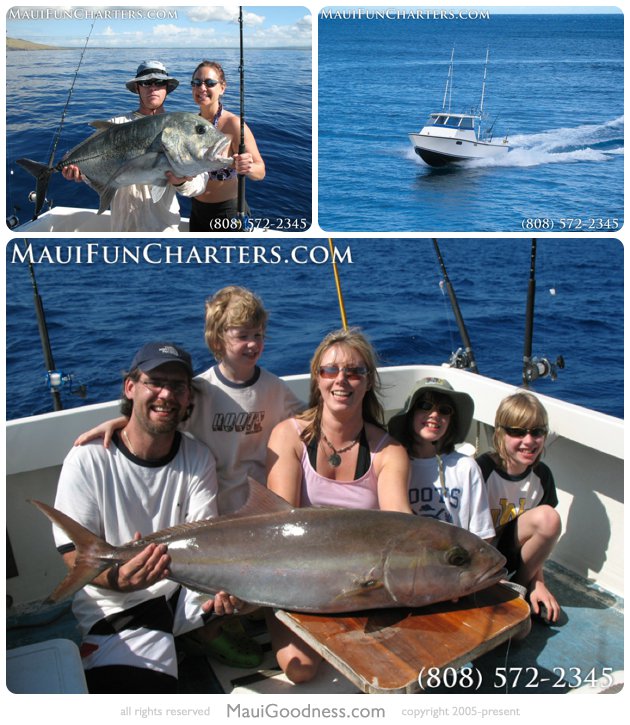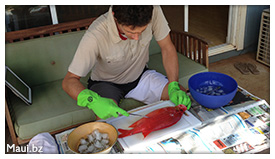 Despite having had lived briefly with a river in my backyard, my total lifetime fishing time probably added up to less than 30 minutes (until this last year.) It’s something that has always interested me, so when I was invited on my 1st Maui spearfishing trip, I jumped at the opportunity.
Despite having had lived briefly with a river in my backyard, my total lifetime fishing time probably added up to less than 30 minutes (until this last year.) It’s something that has always interested me, so when I was invited on my 1st Maui spearfishing trip, I jumped at the opportunity.
Spearfishing on Maui
The act of catching fish on their own turf was a challenge I’ve wanted to take on for a long time. My breath hold time is relatively decent (just over a minute when diving), so I thought it’d be something I could pull off without too much work. I was wrong. VERY WRONG!
Some fun footage during a recent spearfishing session. Lots of sharks!
Breathing
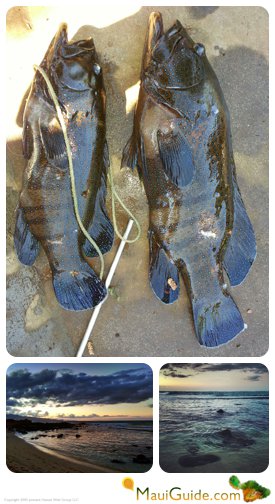
I thought 45 seconds to a minute was plenty of time to catch a fish. NOPE. Learning how to, conserve energy and oxygen is an essential skill. My dive partner can easily stay down for over 2 minutes (when out of shape!) He takes his time swimming down, sits at 45 to 60 feet and waits. There’s a reason why he catches bigger, better, and more fish than me.
Fish Knowledge
Local fish knowledge is crucial. There are still times where I see something big, but I’m not sure whether it’s edible or more useful to the reefs than in my stomach. I know of close to a dozen fish that are ideal to catch, and even with my regular viewing of their images/videos, it’s very hard to tell them apart when below. The deeper you dive, the less color is decipherable. Reds disappear and everything looks blue/grey. The one fish I can always recognize is the Roi. Roi were foolishly introduced by man to our reefs for the purpose of increasing game. What they didn’t take into account is that (though delicious) Roi is destructive to reef life because it eats all the juvenile fish AND it has high levels of Ciguatera (a nasty foodborne illness you don’t want.) So, I do my duty in helping the reef, but I rarely come back with something for dinner.
It’s also important to know how these fish act, where they like to hang out, and what attracts them.
I want MU, Omilu, Moana Kali, Kumu, Uku, Papio, Knifejaw, and the invasive ones: Roi, Toau, Taape
Spearfishing Equipment Guide
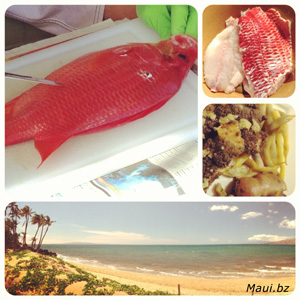 When learning to spearfish, you really need the correct spearfishing equipment/gear. For my first few times spearfishing in Maui, I used a regular snorkel and mask and I was given a sling from my friend. My mask was too big (better for watching fish from the surface), and I lacked a lot of the items that make me more comfortable, help me use less energy, and keep fish from blatantly seeing me.
When learning to spearfish, you really need the correct spearfishing equipment/gear. For my first few times spearfishing in Maui, I used a regular snorkel and mask and I was given a sling from my friend. My mask was too big (better for watching fish from the surface), and I lacked a lot of the items that make me more comfortable, help me use less energy, and keep fish from blatantly seeing me.
Some of the crucial items I soon picked up include:
- Weight Belt – A thick rubber belt with some weights (I use 5-6 lbs) make life much easier. Staying down is a major challenge without them, and you’ll use most of your energy swimming down (decreasing your fishing time.) Also, it’s nice to get a thick, quality belt because when you pull your bands back, it’s nice to have something to dig the butt of the gun against (instead of bruising your waste line.)
- Good Mask – I was using a very big viewing lens, which made it harder to equalize (requiring more air.) A small mask with a mirror surface is a good idea. The less air inside, the easier it is to equalize and less air needed. Also, if the fish can’t see your eyes, that’s a good thing. They’re smarter than you think. I got a black silicon mask that works great.
- Functioning Snorkel – Having enjoyed many snorkel sessions, my snorkel was very used and required duct tape to function. I grabbed a better quality snorkel for sitting at the surface. When you go down, you’ll most likely let go of it and let it dangle, so something smaller is good.
- Good Fins – Fins are very personal. I upgraded from the normal small rubber ones to some fiberglass long fins. They help me draw straight lines without using much energy. The fiberglass is strong, rigid and light. They also sell carbon fiber ones, but they’re very expensive.
- Working Gun/Sling – Using a regular pole sling is fine, if you know what you’re doing. And most experts suggest starting with one. They say if you can catch one with a pole, you can catch almost anything with a gun. Personally, I never caught anything with the pole. It takes close proximity, patience and great aim. Eventually, I’ll go back to it and try again, but I need longer down time.
- Sharp, waterproof Knife – You’ll need a knife that clips on or straps onto your belt or leg. The knife will be used to kill the fish by inserting into the fish brain. Some divers also use to the knife to chum smaller fish or roi in order to attract bigger fish.
- Gloves – Some fish are sharp (and sometimes poisonous.) Having gloves won’t completely protect you from this, but it helps. The gloves also protect you from the reef and make it easier on your hands to pull back the bands.
- Dive buoy with Dive Flag – The last thing you want is to come up with a beautiful, large fish and get killed from a speedboat. The flag is really your only protection from this. It’s also nice to have a nearby buoy to put your fish stringer on.
- Fish Stringer – Once you’ve caught your fish, you have to put it somewhere. Some divers attach it to their body. We prefer to have the stringer hanging from our dive buoy to give it some distance. There’s a good chance you’ll see sharks cruising around, and they’re often waiting for the right moment to steal your fish. I’d rather them steal my fish than my hand along with it. And yes, I’ve lost a fish to a shark already.
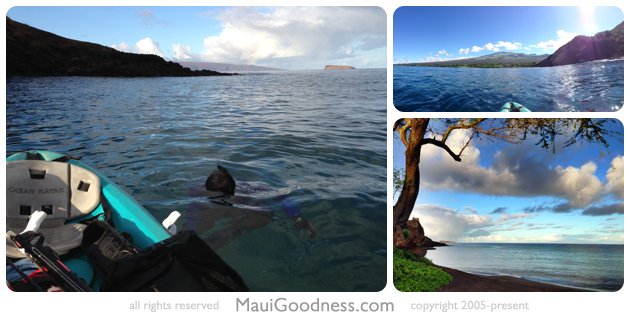
Some other items that make life a lot easier:
- Wetsuit – Some say, why wear a wetsuit in tropical water? Moving as little as possible helps you slow down your heart, which allows for less consumption of oxygen. When you’re not moving and your heart slows, you get cold. Shivering doesn’t help you stay calm and comfortable. Also, the more you can protect your body from reef the better. The reason I wear a full suit is to keep my skin from showing. The less skin you show, the less the fish will notice you (unless you’re swimming around erratically in a neon wetsuit.)
- Booties – Having some neoprene socks or booties keeps you warm, reduces skin exposure, and can stop wear and tear on your ankles from tight fins.
- Hood – Free flowing hair is a dead giveaway to fish that you don’t belong in the ocean. The less attention you attract, the better.
- Dive Watch – It’s crucial to know how long you’re under and how long between dives. The rule of thumb is to stay on the surface for at least 3 times as long as you’re down. So, if you’re down for a minute, stay up for 3. I usually stay on the surface for around 5 minutes to be safe and keep my heart rate down. You don’t need a great watch for this ( use a cheap waterproof watch that has a timer.) For serious divers, a dive watch that measures depth is a pretty cool thing to have.
- Kayak/Boat with Anchor – Being able to access reefs that are further offshore allows you opportunities for less fished grounds and bigger fish.
- Dry Bag – It’s nice to bring a snack for when we’re done, or carry my keys, phone, etc on the boat.
- Phone Protection – I bought one of those cheap plastic covers that make my phone waterproof so I can bring the phone on the kayak or boat. It’s nice to have in case the motor goes out or other emergencies.
- GoPro – We are incredibly thankful to have had a GoPro onboard with us. A month ago, we got mugged by a humpback whale moments before we intended to dive. We got amazing footage (see video below.)
- Spearfishing Gun with Reel – Having a good gun makes it so much easier to catch fish. Having a solid reel is very helpful too. There have been numerous times where I’ve shot a fish and it bolts into a hole in the reef. Instead of dropping my gun, I go to the surface and take my time going down again. It’s also helpful if you catch a bigger fish that you need to fight for a while. You can let it swim away and sit on the surface while it tires out. Just be careful about possibly getting tangled in the line. You can also have issues with the line getting tangled on the reef. Not fun.
- Antifog – Some use expensive antifog solution for their masks, some use saliva. I like using mint toothpaste. It works well, is cheap and smells good.
- Transparent Cord with Filament – Having a cord from your buoy to your gun is very helpful, especially if you don’t have a reel. It keeps your dive flag with you at all times, which is a good safety feature and it’s convenient when you want to use the stringer to hold your fish.
- Water Bottle – Though food isn’t the best idea before or during a dive, water is crucial. I know from experience how dangerous dehydration can be.
- Cooler With Ice – If you catch anything, you’ll want a cooler for storing the fish along with water and ice. We usually bring an old cooler (lined with a garbage bag) and a pre-frozen large water bottle. That way, we can fill it with salt water and leave the bottle in there. It does the trick.
This is just before we were spearfishing. Best experience of our lives! Maui no ka oi!
Spearfishing Safety Guide
Spearfishing can be a dangerous sport. There are sharks, shallow water blackouts, currents, sharp reef, and much more. Below are a few things I’ve learned (both from advice and poor choices.)
- Go with a buddy. Take turns diving.
- Call someone and let them know when and where you’re going.
- Use a dive flag.
- Carry your gun correctly and use a safety.
- Be careful of your fishing line getting tangled up.
- Be mindful of sharks and know what to do when it comes close.
- Diversify where you dive.
- Stay hydrated.
- Dive within your comfort zone. Don’t stay down longer than you should.
- Always dive within viewing distance of your partner.
- Be very careful when grabbing your fish (don’t get jabbed or cut.)
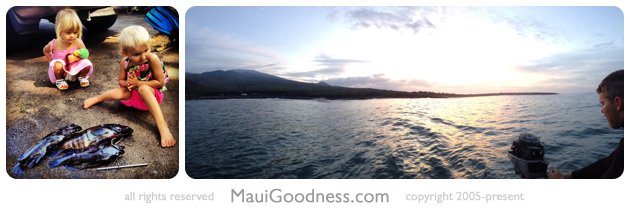
In Conclusion
Spearfishing is my new love. Though I’m crazy about it and can’t do it enough, it’s a major commitment of both time and money to do it correctly and safely. I’m still learning and still acquiring gear.
I went fishing with Maui Fun Charters on their amazing boat (The Marjorie Ann), and was exposed to an entirely different world of fishing. It was an eye opening experience going from the enormous challenges of spearfishing to a day in the sun on a high-tech boat with all the amenities. Speeding along a bright blue ocean, enjoying warm tropical breezes, exposed to unreal Maui views, all while sipping cold beer and enjoying hilarious conversation with friends can’t be beat. OH, and we fished too! Fishing with a rod is truly a gentlemen’s sport. If I’d started fishing this way first, I may have never gotten into spearfishing. Though spearfishing and coming up empy handed after a long session can be incredibly frustrating, the exercise and beauty of the reef is satisfying. In contrast, fishing from a boat and coming in empty handed (which hasn’t happened yet) would probably be much less frustrating since you get to enjoy fun on the water with friends.
